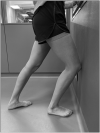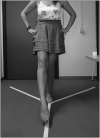Effects of Mulligan Mobilization with Movement in Subacute Lateral Ankle Sprains: A Pragmatic Randomized Trial
- PMID: 33634747
- PMCID: PMC8725747
- DOI: 10.1080/10669817.2021.1889165
Effects of Mulligan Mobilization with Movement in Subacute Lateral Ankle Sprains: A Pragmatic Randomized Trial
Abstract
Objective: In a pragmatic and randomized clinical trial, patients with lateral ankle sprains were assessed, under blinded conditions, for their responsiveness and improvements during Mulligan mobilization-with-movement (MWM) therapy. Methods: Overall, 51 participants with subacute lateral ankle sprains (Grade I-II) were recruited. Following an MWM screening procedure, responders were randomized to either an intervention group (MWM) or a sham group. The MWM group received inferior tibiofibular, talocrural, or cubometatarsal MWM. The treatment or sham was administered upon three sessions, each 4 days apart. Changes from baseline were measured and compared between the sessions for dorsiflexion range of motion, pain, stiffness perception, and the Y-balance test. Results: In total, 43 participants were considered responders to MWM. Using a two-way repeated-measure ANOVA, a statistical and clinically meaningful improvement in dorsiflexion range of motion was revealed in the MWM group (p = 0.004, 1rst = +1.762 cm; 3rd = +2.714 cm), whereas no improvement following the first session occurred in the sham group (p = 0.454, 1rsttrial = +1.091 cm; 3rdtrial = +1.409 cm). Pain and stiffness significantly improved, yet below the clinically meaningful level. The MWM group demonstrated a significant improvement after three sessions for the Y-balance test (p = 0.001, +8.857 cm). Conclusion: More than 80% of participants with subacute lateral ankle sprains responded well to the MWM approach. Three sessions of pragmatically determined MWM provided a significant and clinically meaningful benefit in dorsiflexion range of motion and Y-balance test performance compared to a sham treatment.
Keywords: Ankle sprain; manual therapy; mobilization with movement; mulligan; pragmatic study; weight-bearing lunge test.
Conflict of interest statement
No potential conflict of interest was reported by the authors.
Figures





Similar articles
-
Inferior tibiofibular joint mobilization with movement and taping does not improve chronic ankle dorsiflexion stiffness: a randomized placebo-controlled trial.J Man Manip Ther. 2021 Apr;29(2):73-82. doi: 10.1080/10669817.2020.1805690. Epub 2020 Aug 18. J Man Manip Ther. 2021. PMID: 32808592 Free PMC article. Clinical Trial.
-
Initial changes in posterior talar glide and dorsiflexion of the ankle after mobilization with movement in individuals with recurrent ankle sprain.J Orthop Sports Phys Ther. 2006 Jul;36(7):464-71. doi: 10.2519/jospt.2006.2265. J Orthop Sports Phys Ther. 2006. PMID: 16881463 Clinical Trial.
-
The immediate effects of two manual therapy techniques on ankle musculoarticular stiffness and dorsiflexion range of motion in people with chronic ankle rigidity: A randomized clinical trial.J Back Musculoskelet Rehabil. 2018;31(3):515-524. doi: 10.3233/BMR-170963. J Back Musculoskelet Rehabil. 2018. PMID: 29309040 Clinical Trial.
-
Effect of Mobilisation with Movement (MWM) on clinical outcomes in lateral ankle sprains: A systematic review and meta-analysis.Foot (Edinb). 2020 Jun;43:101657. doi: 10.1016/j.foot.2019.101657. Epub 2019 Nov 28. Foot (Edinb). 2020. PMID: 32247262
-
The effectiveness of mobilization with movement at improving dorsiflexion after ankle sprain.J Sport Rehabil. 2010 May;19(2):226-32. doi: 10.1123/jsr.19.2.226. J Sport Rehabil. 2010. PMID: 20543222 Review.
Cited by
-
Lack of pragmatic attitude of self-labelled pragmatic trials on manual therapy: a methodological review.BMC Med Res Methodol. 2024 Nov 11;24(1):273. doi: 10.1186/s12874-024-02393-1. BMC Med Res Methodol. 2024. PMID: 39528934 Free PMC article. Review.
-
Physiotherapy Rehabilitation Strategies for Post-operative Trimalleolar Ankle Fracture: A Case Report.Cureus. 2022 Sep 28;14(9):e29716. doi: 10.7759/cureus.29716. eCollection 2022 Sep. Cureus. 2022. PMID: 36340551 Free PMC article.
-
Efficacy of adding mobilization and balance exercises to a home-based exercise program in patients with ankle disability: a randomized controlled trial.Front Med (Lausanne). 2025 Feb 19;12:1512587. doi: 10.3389/fmed.2025.1512587. eCollection 2025. Front Med (Lausanne). 2025. PMID: 40046922 Free PMC article.
-
The effectiveness of mulligan mobilization with movement (MWM) on outcomes of patients with ankle sprain: a systematic review and meta-analysis.BMC Sports Sci Med Rehabil. 2025 Apr 29;17(1):105. doi: 10.1186/s13102-025-01121-6. BMC Sports Sci Med Rehabil. 2025. PMID: 40301893 Free PMC article.
-
Chiropractic Management of Chronic Ankle Pain and Limited Mobility in a Pediatric Athlete: A Case Report.J Chiropr Med. 2023 Mar;22(1):85-88. doi: 10.1016/j.jcm.2022.10.001. Epub 2022 Dec 13. J Chiropr Med. 2023. PMID: 36844988 Free PMC article.
References
-
- Gribble PA, Bleakley CM, Caulfield BM, et al. Evidence review for the 2016 international ankle consortium consensus statement on the prevalence, impact and long-term consequences of lateral ankle sprains. Br J Sports Med. 2016;50(24):1496–1505. - PubMed
-
- Doherty C, Delahunt E, Caulfield B, et al. The incidence and prevalence of ankle sprain injury: A systematic review and meta-analysis of prospective epidemiological studies. Sport Med. 2014;44(1):123–140. - PubMed
-
- Fong DT, Hong Y, Chan L, et al. Review on ankle injury and ankle sprain in sports. Sport Med. 2007;37(1):73–94. - PubMed
-
- Delahunt E, Coughlan GF, Caulfield B, et al. Inclusion criteria when investigating insufficiencies in chronic ankle instability. Med Sci Sports Exerc. 2010;42(11):2106–2121. - PubMed
-
- Delahunt E, Bleakley CM, Bossard DS, et al. Clinical assessment of acute lateral ankle sprain injuries (ROAST): 2019 consensus statement and recommendations of the international ankle consortium. Br J Sports Med. 2018;52(20):1304–1310. . - PubMed
Publication types
MeSH terms
LinkOut - more resources
Full Text Sources
Other Literature Sources
Medical
Miscellaneous
